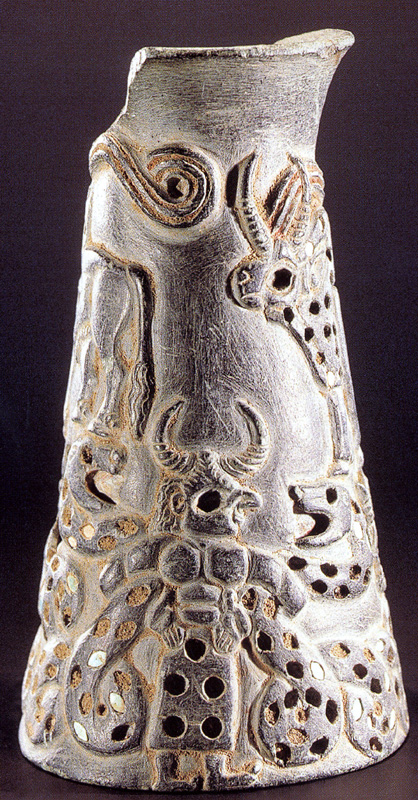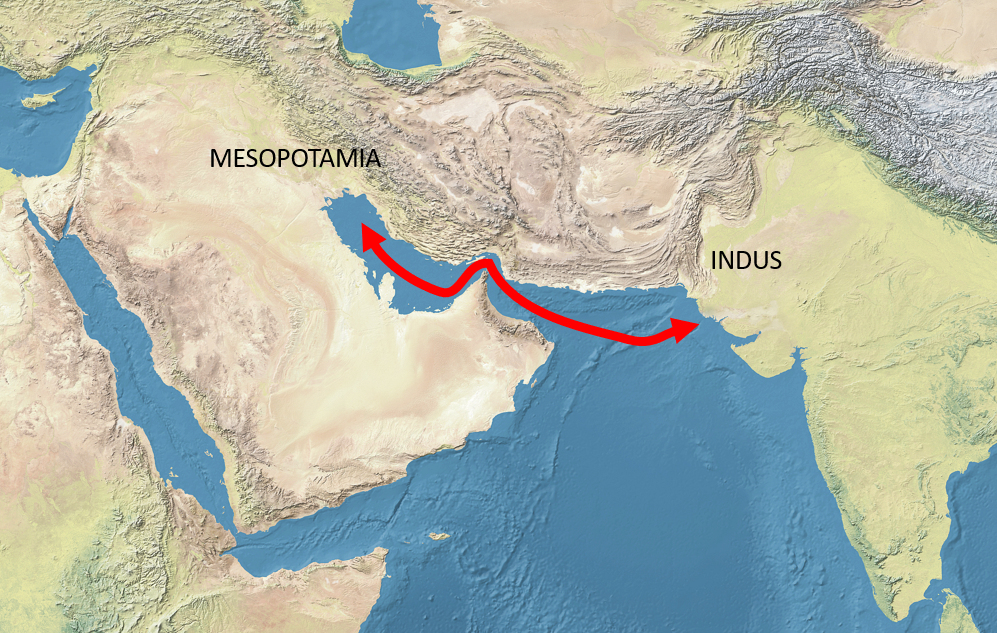The Elamite civilization: A cultural and political powerhouse of ancient Iran
The Elamite civilization, flourishing between approximately 2700 BCE and 539 BCE, was a significant and complex society located in the region corresponding to modern-day southwestern Iran. As one of the earliest civilizations in the Near East, Elam played a crucial role in shaping the cultural and political dynamics of ancient Mesopotamia and beyond. Renowned for its advanced administration, artistic achievements, and interactions with neighboring civilizations, Elam represents a vital link in the broader narrative of early human development.
 Map showing the area of the Elamite Empire (in orange) and the neighboring areas. Elam is located in modern-day southwestern Iran. At its time, it laid Southeast of Mesopotamia, in particular, East of the Sumerian city-states. The approximate Bronze Age extension of the Persian Gulf is shown. Source: Wikimedia Commonsꜛ (license: CC BY-SA 3.0)
Map showing the area of the Elamite Empire (in orange) and the neighboring areas. Elam is located in modern-day southwestern Iran. At its time, it laid Southeast of Mesopotamia, in particular, East of the Sumerian city-states. The approximate Bronze Age extension of the Persian Gulf is shown. Source: Wikimedia Commonsꜛ (license: CC BY-SA 3.0)
Origins and early development
The origins of the Elamite civilization can be traced to the Early Bronze Age, around 2700 BCE, with early settlements concentrated in the fertile lowlands of Khuzestan and the Zagros Mountains. Susa, one of the oldest cities in the region, became a prominent center of political and cultural activity. The Proto-Elamite period (ca. 3100–2700 BCE) saw the emergence of writing systems, administrative practices, and monumental architecture that laid the foundation for later developments.
 Timeline of Elam. Source: Wikimedia Commonsꜛ (license: CC BY-SA 4.0)
Timeline of Elam. Source: Wikimedia Commonsꜛ (license: CC BY-SA 4.0)
During the Old Elamite period (ca. 2700–1600 BCE), the civilization consolidated into a kingdom with centralized governance. This era was characterized by interactions and conflicts with Mesopotamian city-states, such as Ur and Akkad, as Elam sought to assert its influence in the region. The strategic location of Elam along trade routes facilitated economic prosperity, connecting it with Mesopotamia, the Indus Valley, and Central Asia.
Cultural achievements and society
Elamite culture is best known for its innovative contributions to art, architecture, and administration. Elamite artisans produced intricate metalwork, pottery, and sculptures that blended local traditions with influences from Mesopotamia. Temples and ziggurats, such as those at Susa and Chogha Zanbil, showcased the civilization’s architectural ingenuity and religious devotion.
 The Chogha Zanbil ziggurat site, built c. 1250 BCE. Source: Wikimedia Commonsꜛ (license: CC BY-SA 3.0)
The Chogha Zanbil ziggurat site, built c. 1250 BCE. Source: Wikimedia Commonsꜛ (license: CC BY-SA 3.0)
The Elamites developed their own script, known as Linear Elamite, alongside the adoption of Akkadian cuneiform for administrative purposes. These writing systems enabled the efficient management of resources and the recording of legal, economic, and religious texts. The use of written records highlights the sophistication of Elamite governance and its role as a precursor to later Persian administrative practices.


Left: Kneeling Bull with Vessel. Kneeling bull holding a spouted vessel, Proto-Elamite period, (3100–2900 BCE). Source: Wikimedia Commonsꜛ (license: CC BY-SA 2.0) – Right: Orant figure, Susa IV, 2700–2340 BCE. Source: Wikimedia Commonsꜛ (license: public domain)
Elamite society was hierarchical, with kings and a powerful priesthood at the top, supported by nobles, scribes, and artisans. Women held significant positions in Elamite society, with queens and priestesses playing active roles in political and religious life. This relative prominence of women distinguishes Elam from many contemporary civilizations.


Left: Relief of a woman being fanned by an attendant while she holds what may be a spinning device before a table with a bowl containing a whole fish (700–550 BCE). Source: Wikimedia Commonsꜛ (license: CC BY-SA 2.0) – Right: Elamite archer fighting against the Neo-Assyrian troops of Ashurbanipal, and protecting wounded king Teumman (kneeling), at the Battle of Ulai, 653 BCE. Source: Wikimedia Commonsꜛ (license: CC BY-SA 2.0)


Left: A carved chlorite vase decorated with a relief depicting a “two-horned” figure wrestling with serpent goddesses. The Elamite artifact was discovered by Iran’s border police in the possession of historical heritage traffickers, en route to Turkey, and was confiscated. Source: Wikimedia Commonsꜛ (license: CC BY-SA 3.0) – Right: Elamite reliefs at Eshkaft-e Salman. The picture of a woman with dignity shows the importance of women in the Elamite era. Source: Wikimedia Commonsꜛ (license: CC BY-SA 2.0)
Trade and connectivity
Trade was a cornerstone of the Elamite economy. Elam’s location made it a critical link between Mesopotamia, the Iranian Plateau, and the Indus Valley. Goods such as textiles, lapis lazuli, and metals flowed through Elamite cities, fostering cultural and technological exchanges. The civilization’s involvement in long-distance trade contributed to its wealth and cultural diversity.
 Proto-Elamite (Susa III) cylinder seal, 3150–2800 BCE. Seals like this were used to mark ownership and authenticate documents. They were enrolled on clay tablets and impressed on wet clay to create a raised pattern. Source: Wikimedia Commonsꜛ (license: CC BY-SA 2.0)
Proto-Elamite (Susa III) cylinder seal, 3150–2800 BCE. Seals like this were used to mark ownership and authenticate documents. They were enrolled on clay tablets and impressed on wet clay to create a raised pattern. Source: Wikimedia Commonsꜛ (license: CC BY-SA 2.0)
Elam’s interactions with neighboring regions extended beyond commerce. The civilization engaged in diplomatic marriages, alliances, and conflicts with Mesopotamian empires, such as Akkad, Babylon, and Assyria. These interactions shaped the political landscape of the ancient Near East, with Elam often serving as a counterbalance to Mesopotamian hegemony.

Trade routes between Mesopotamia and the Indus would have been significantly shorter due to lower sea levels in the 3rd millennium BCE. Source: Wikimedia Commonsꜛ (license: CC BY-SA 3.0)
Comparisons with other civilizations
Mesopotamia
Elam and Mesopotamia shared many cultural and technological innovations, including writing, ziggurat construction, and complex administrative systems. However, Elam retained distinct traditions, such as its unique script and artistic styles. While Mesopotamian city-states often competed for dominance, Elam’s centralized governance allowed it to maintain a more cohesive political structure.
Egypt
Like Egypt, Elam developed monumental architecture and a centralized administration. Both civilizations emphasized religious practices and the divine authority of rulers. However, while Egypt’s isolation along the Nile fostered stability, Elam’s proximity to Mesopotamia exposed it to frequent conflicts and cultural exchanges, resulting in a more dynamic and adaptable society.
Minoan and Mycenaean civilizations
The Elamite civilization’s trade networks and artistic traditions bear similarities to those of the Minoans and Mycenaeans. All three civilizations acted as cultural intermediaries, facilitating the exchange of ideas and goods across their respective regions. Unlike the palace-centered economies of the Minoans and Mycenaeans, Elamite cities such as Susa functioned as administrative and religious hubs within a broader territorial state.
India
Elam’s connections with the Indus Valley Civilization highlight its role in early trans-regional trade. Both civilizations shared an emphasis on urban planning, metallurgy, and craft production. However, while the Indus Valley lacked monumental architecture, Elam’s ziggurats and temples reflected a focus on religious and political centralization.
Decline and legacy
The decline of the Elamite civilization began in the first millennium BCE, as external pressures from Assyria and internal fragmentation weakened the kingdom. The conquest of Elam by the Persian Empire in 539 BCE marked the end of its political independence. However, Elamite culture and administrative practices significantly influenced the Achaemenid Empire, ensuring its legacy endured.
Elam’s contributions to art, writing, and governance provide a critical link between the ancient civilizations of Mesopotamia and the Iranian Plateau. The archaeological remains of cities like Susa and Chogha Zanbil continue to shed light on the complexity and resilience of this early civilization.
References and further reading
- Walther Hinz, The Lost World of Elam: Re-Creation of a Vanished Civilization, 1972, Routledge, ISBN: 978-0283978630
- D.T. Potts, The Archaeology of Elam: Formation and Transformation of an Ancient Iranian State, 2016, Cambridge University Press, ISBN: 978-1107476639
- Javier Álvarez-Mon, The Art of Elam: Culture, Representation and Identity, 2020, Routledge, ISBN: 978-0415814744
- Elizabeth Carter and Matthew W. Stolper, Elam: Surveys of Political History and Archaeology, 1984, University of California Press, ISBN: 978-0520099500
- Pierre Amiet, Art of the Ancient Near East, 1980, Harry N. Abrams, ISBN: 978-0810906389
- Peter Roger Stuart Moorey, Ancient Mesopotamian Materials and Industries: The Archaeological Evidence, 1994, Oxford University Press, ISBN: 978-1575060422
- Richard N. Frye, The Heritage of Persia, 1993, Mazda Publishers, ISBN: 978-1568590080
- Marvin A. Powell, Labor in the Ancient Near East, 1987, American Oriental Society, ISBN: 978-0940490680
- Guillermo Algaze, The Uruk World System: The Dynamics of Expansion of Early Mesopotamian Civilization, 1993, University of Chicago Press, ISBN: 9780226013781
- Wikipedia article on Elamꜛ





























comments